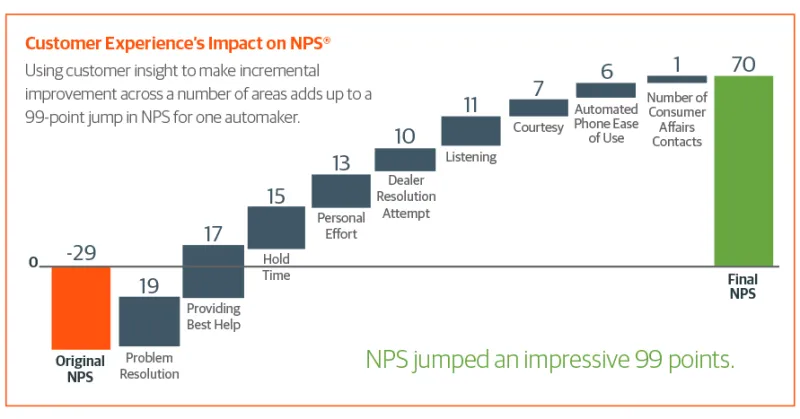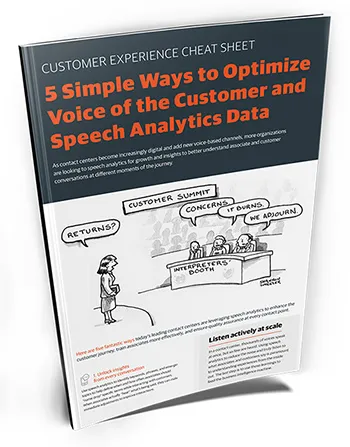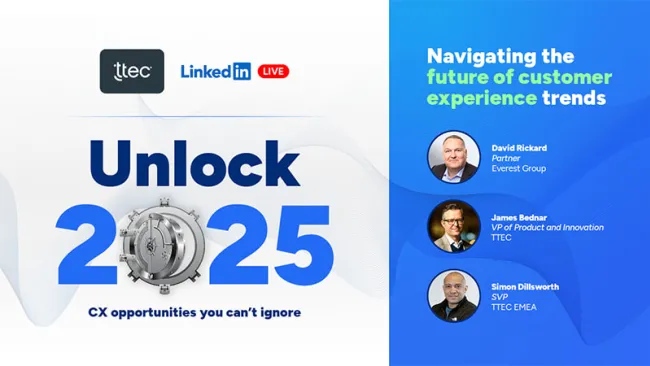Top performing companies always have a clear view of the customer journey. This ensures major KPIs, such as quality score, average handle time, and contact resolution rates, are optimized. And yet, fewer than 10% of companies have that 360-degree view of their customer journeys. As a result, contact center performance suffers. For this reason, when looking at ways to improve CX and optimize call center performance, better utilization of contact center analytics is a great place to start.
Of course turning data into meaningful customer analytics is easier said than done. Not to worry. This article provides contact center analytics best practices so your organization can discover actionable insights to positively impact business outcomes.
First we'll outline some of the main types of analytics and key strategic steps in how to think about, organize, and operationalize the call center analytics. Then we'll dive into six ways that call center analytics software can help improve agent and customer experiences. Lastly, we'll provide some use cases and additional resources to help you discover how advanced analytics can drive business results.
Contact center analysis requires looking at many types of customer and channel data
As the number of customer engagement channels grows so too has contact center volume. As a result, it has become even harder to maintain a consistent experience across interaction touchpoints. These poor experiences and channel breakdowns can seriously impact churn and in turn, revenue. For example, in this infographic we've highlighted some key research findings that show how much contact center analytics can positively impact business outcomes. It also indicates just how few companies are actually maximizing the value customer analytics can provide.
Before we discuss how analytics impacts business outcome, it is important to first define three general categories of analytics. In isolation, each of these provides useful insights, but when joined together, like a collection of puzzle pieces, they form an invaluable picture of the entire customer journey. This allows you to better understand your customers and increase customer loyalty and lifetime value. It also provides you actionable insights on how to improve call center operations and customer satisfaction (CSAT).
What are Contact Center Analytics?
Contact Center Analytics are the analysis of standard contact center metrics to identify trends, impacts, causes and results.
What are Customer Analytics?
Customer Analytics is the analysis of multiple customer-related data sources to identify customer trends, interaction opportunities, and to serve as a source for modeling. They can be historical or predictive. Data sources include voice of the customer, behavior data, demographics, and purchase data.
What are Speech Analytics?
Speech Analytics are the analysis of transcribed voice and ingested text engagements along with metadata including CRM and notes to identify trends, voice of the customer insights, performance drivers, and other insights.
What are Predictive Analytics?
Predictive Analytics is the use of big data, artificial intelligence, advanced algorithms, and intuitive machine learning techniques to create predictions about future results based on historical data. In addition, predictive analytics allow you to calculate expected customer lifetime value, anticipate future consumer behavior, and identify customers likely to churn.

Want actionable 360-degree customer views? Start with these best practices
With the massive volumes of data out there, organizations have an opportunity (and challenge) to create a 360-degree view of the customer that produces actionable insights and decisions. If this seems like a daunting task—it is—but not too worry. Our call center business intelligence consulting experts have developed some best practices for simplifying customer data into meaningful customer insights.
Don't mistake the part for the whole
For many businesses, data is both the key to important insights and an obstacle to getting answers. While there isn’t an easy way to connect disparate data, call center analytics software that incorporate both structured and unstructured in the center environment can go a long way in helping.
Have a call center analytics company help you optimize
Even companies that are rich in data and analytics may need help optimizing their insights or fixing a data blind spot. Customer centric, call center analytics companies can help aggregate digital and offline customer data into a common architecture and gather a 360-degree view of customer needs, behaviors, and preferences.
When it comes to call center data, sometimes less is more
How do you decide which insights to pursue and when? Instead of setting a broad goal for better insights, remember that less is more. To figure out which types of insights to pursue first use a prioritization framework to evaluate your needs. Questions to consider include: What types of insights does your team hope to gain? Which ones are likely to deliver immediate versus future results? What data/channels/sources are available and what holes need to be filled? Answering these questions early on will make it easier to stay focused on the plan.
Make sure employees are ready to act on the insights
Insights gained through analytics are only useful if they’re deployed to help improve agent productivity. But how many employees are ready to regularly embed analysis, data, and evidence-based reasoning into their decision-making processes? Data-driven insights and decision-making can create better customer experiences that differentiate a brand but only if the right strategy, technology, and people are in place.
Smarter call center and contact center analytics equals smarter business
Analytics tools hold the key to working smarter and having real impact across channels. Big data gathered during a service interaction can offer incredible insights to the rest of the organization. This business intelligence allows companies to understand their customers more clearly and influence proactive and predictive customer strategies. We believe there are six key principles—driven by technology-enabled analytics—that can guide contact center leaders in their organizational decision making:
1. Get to the root of the interaction
When customers contact your company, even if for apparently mundane reasons, they become a valuable source of information about your business and operations. Most contact centers desire deflection of such contacts to low-cost channels and do not necessarily pay attention to root causes. Root cause analytics can highlight fundamental issues and inform solutions. This can reduce overall interaction volume, call times, and significantly increase customer satisfaction.
Root cause analytics may reveal the need to make changes outside the contact center. Examples might include coordinating marketing communications across channels, redesigning bill layout, making Web self-service more intelligent, and issuing proactive alerts.
2. Self-service can, and should be, intelligent
Both companies and customers desire self-service tools. They exist as FAQs, searchable knowledgebases, or even avatars, and they can help lower hold times and abandonment rates by letting customers explore topics and find their own answers.. However, many self-service options powered by artificial intelligence are actually dumb-—they do not provide the right answers or provide too many possible answers, leaving customers frustrated. Advances in text analytics and speech analytics software and machine learning can help self-service tools to select highly accurate responses to customer inquiries. These are highly automated systems that are self-learning, so accuracy improves over time, as the amount of historical data increases. The one pre-requisite for these systems is a rich knowledgebase. But when implemented effectively, intelligent self-service is a great deflection strategy by reducing the number of calls.
3. Empower and transform your front line contact center associates
Too often call center agents have high attrition. They work in a high-stress environment and are treated only as a cost by companies, and as a result, agent performance suffers. Instead, contact center associates should be viewed as employees who can earn the trust and loyalty of customers during critical moments of truth when customers expend a lot of emotional energy. Success during these types of calls or interactions can drive significant positive business outcomes.
Examples of these moments could include events like a missed flight to attend an important meeting, a lost credit card when traveling overseas, or a stalled vehicle late at night in an unfamiliar area. During these moments, smart technological solutions alone won't cut it, because complex solutions are required, and because center technology alone cannot create an emotional bond. However, emotionally intelligent frontline employees, empowered with the appropriate technology and data at their fingertips, can excel in these situations and create sustainable differentiation. Take the time to determine who within your organization has the emotional intelligence to succeed as brand stewards during the most fragile service interactions.
4. Discover the right channels for customer interactions
Many companies have begun to right channel contact center interactions, or assign specific interactions to specific channels. But analytics tools are required to make the correct workflow decisions in routing a customer call. It is instructive to look at four factors: customer channel preference, customer profiles and behaviors (commonly available in transactional and other data), interaction complexity (e.g., interactions that require significant diagnostics to solve), and moments of truth, where the outcome will have significant implications for customer retention and customer loyalty.
Only very high complexity interactions that occur during extremely critical moments of truth should be handled by frontline live employees, with the rest moved to other low cost channels like self-service, chat, or SMS.
5. Follow and inform the customer journey across channels
Today's call center operations are siloed by channels, and sometimes even within a channel. While sophisticated omnichannel contact centers with robust channel orchestration provide a better view of the full customer journey, they also often lack the center solutions needed to analyze data as effectively and quickly as needed. Without powerful contact center analytics software in place, companies miss out not only on successfully resolving customers current needs and questions, but also on anticipating their future needs and next questions. Many senior leaders understand the problem and want to turn the multichannel experience into a true omnichannel solution, but are often limited by behemoth legacy infrastructures supporting their center environments. This makes getting a holistic view of all relevant contact center analytics difficult.

Companies can enable a scalable, massively parallel processing, cloud based contact center analytics software solution that includes three advanced customer insight capabilities.
To make the most of this solution, first companies must enable real-time and batch data ingestion (both structured and unstructured) from multiple channels, touchpoints, and enterprise systems like CRM. This will facilitate a live customer profile and context as customers move along their journey with the company.
Next, get predictive. Analytics-enabled recommenders can implement a multitude of analytic engines, such as interaction reason prediction, sense and respond, next interaction predictor, or next best offer optimizer. These tools are designed to provide the best response in the best channel and takes into account context, customer behavior and history, customer preference, and issue complexity.
Finally, make sure channels are connected. Use channel connectors that seamlessly connect via open APIs/custom integration with various channels to orchestrate response. This applies to self-service channels as well as live channels where the actions may be orchestrated in the IVR or at the associate's desktop. And be sure to allot for future experience channels, to be as nimble and flexible to changing customer behaviors.
6. Pre-empt customer interactions with contact center predictive analytics
Most customer support interactions are inbound calls or other inbound channels. So what if we were able to pre-empt them and solve the customer issue before the customer even reaches out to interact? This would not only reduce interaction volume and improve wait times but also delight customers. Predictive analytics can help. They can be used to identifying patterns and predict interaction reasons even before customer and agent interactions happen.
For example, if call center data analytics showed that customers who had Problem X (e.g., install issues with Internet service) also tended to have Problem Y (e.g., wireless network setup issues), then a customer who reached out with Problem X would be prompted to check and solve for Problem Y during the same interaction, thereby reducing repeat call incidence, improving FCR, and improving customer satisfaction. Or, a company that monitors its self-service interactions can identify an issue alert customers who may be experiencing similar issues, even if they haven't contacted the company about the problem.
Next gen call center analytics at work
Recently, a large telecommunications provider wanted to increase call deflection and improve first call resolution (FCR). We analyzed its call volume, taking into account both where customers were in their lifecycle with the firm, as well as their value to the company as determined by product mix owned. This analysis led to several recommendations that would lead to a reduction in total interaction volume, a deflection of interactions to low or no cost channels, and a 50 percent overall estimated annual cost reduction. In addition, an analytic engine designed to predict likelihood of a repeat call was developed, thereby enabling an improvement in FCR.
And a leading automaker's contact center was exhibiting deteriorating NPS performance, which had been identified as the key metric to influence. Data collected from customer surveys determined which customer experience improvements would lead to a significant boost in NPS. Predictive analytics identified prioritized improvements that would lead to an NPS improvement from – 29 to +70 (see the above chart).
Conclusion: Contact center analytics solutions can supercharge your business operations
Contact centers today are ready to lead a paradigm shift and drive transformative customer experiences for companies and customers. TTEC's Call Center and Contact Center Analytics team can help you establish a strategic approach to analytics in order to get there.
More contact center and call center analytics use cases and resources to explore
Call center customer analytics blind spots and how to avoid them: Many organizations don’t even realize they are sitting on a goldmine of insights within their contact center. Customer analytics that include many different data sources enable businesses to understand not just what happened, but also, who, why, and what next? By combining customer sentiment and voice of the customer data with marketing, product, and sales data, companies have a better understanding of who their customers are, why they’re contacting the brand, which campaigns resonate, and more.
How to Extract the Top 3 Contact Center CX Metrics that Matter: Making sense of contact center data analytics is crucial to knowing when and how your customers’ attitudes change toward your brand – so you can pivot quickly, respond better, lower wait times, and deliver excellent CX as your customers’ needs evolve.

5 Simple Ways to Optimize Voice of the Customer and Speech Analytics Data: In this guide, learn 5 ways to use speech and text analytics, call recordings, and call center software to augment employee experiences on the floor and customer experience over the phone. Today’s leading contact centers leverage speech analytics technology to enhance customer experience, train associates more effectively, and ensure quality assurance (QA) across all channels and at every contact point. Leverage speech analytics technology more effectively to better understand associate and customer conversations across the entire journey. Evaluate reasons for abandoned calls, factors impacting average handle time (AHT), and discover signals to guide ways to improve customer service.
Unlock Customer Insights Hidden in Plain Sight: Customers have multiple contact options today beyond just phone calls. IVR, online self-service, virtual assistants, live chat, online forums, mobile apps, social media, and more. Chances are, you’re not optimizing the customer insights living in your contact center and beyond, across all of these touchpoints. In this strategy guide, we explain how businesses can combine existing data from multiple sources and start applying customer insights to deliver personalized and engaging customer experiences and operational objectives.
Channel Orchestration: Make Your CX Efforts Sing: True channel orchestration requires a full view of the customer journey so that you can align the best channels to the right interactions. There are many types of call center analytics. In this blog post, our call center business intelligence consulting experts outline 4 keys to successfully integrating many aspects of contact center analytics across multiple channels in order to make your CX orchestration sing.
Be Proactive with Speech Analytics for Sales: When looking at how to improve call center analytics to increase sales and customer lifetime value, speech analytics is an invaluable tool. Speech analytics can help your sales team better understand the phrases, trends, and sentiment behind every successful interaction. That's why it's up to your organization to use speech analytics to drive sales revenue and create moments that truly matter with your customer.















